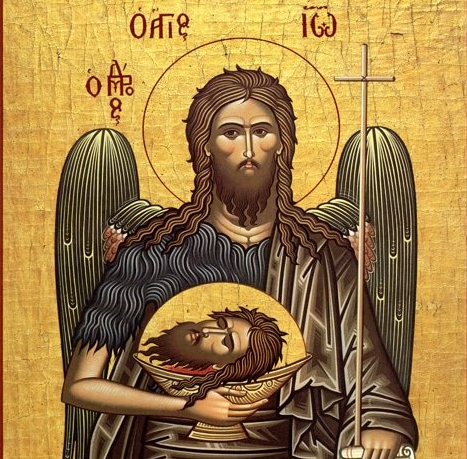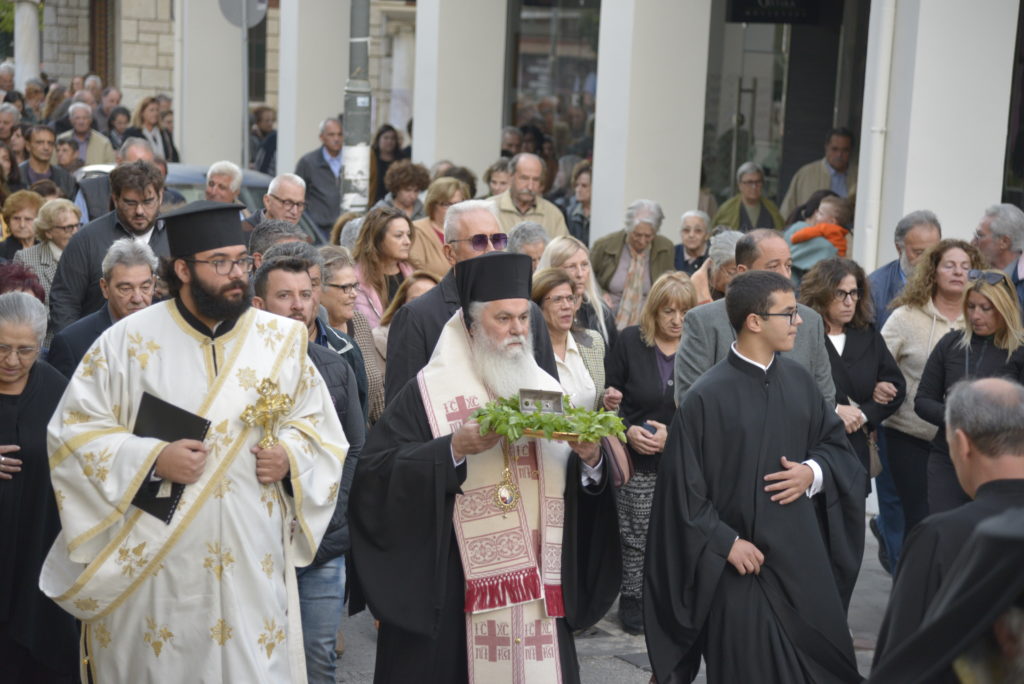Feast Day of the Synaxis of Agios Ioannis the Baptist

On January 7, the Greek Orthodox church celebrates the Feast Day of the Synaxis of Agios Ioannis the Baptist and Holy Forerunner of Christ, who is also the Protector Saint of God Parents, as he baptised Jesus Christ.
In the Orthodox Church, it is customary, on the day following the Great Feasts of the Lord and the Mother of God, to remember those saints who participated directly in the sacred event. So, on the day following the Theophany of the Lord, the Church honors the one who participated directly in the Baptism of Christ, placing his own hand upon the head of the Savior.
Saint John, the holy Forerunner and Baptist of the Lord, whom the Lord called the greatest of the prophets, concludes the history of the Old Testament and opens the era of the New Testament. The holy Prophet John bore witness to the Only-Begotten Son of God, incarnate in the flesh. Saint John was accounted worthy to baptize Him in the waters of the Jordan, and he was a witness of the Theophany of the Most Holy Trinity on the day of the Savior’s Baptism.
St. John was the son of the Prophet Zacharias and Elizabeth, who was a cousin of the Virgin Mary. St. John is known as the “Forerunner” and “Baptist.” He is known as the Forerunner because he preceded Christ and taught repentance, which prepared men for Jesus’ teaching and His ministry. He even recognized Christ as the Messiah as early as when they were both still in their mothers’ wombs. According to Holy Tradition, the Virgin Mary went to visit her cousin Elizabeth and when they embraced John leapt in his mother’s womb, which is considered his first acknowledgment of Christ as Messiah.
After his birth, St. John’s father Zacharias was murdered in the temple. He and his mother fled to the desert and he was raised there. Thus he lived as an ascetic from the earliest part of his life. He ate plants and roots and wore rough clothing. When he grew, he baptized people in the Jordan, teaching repentance, but also saying that someone greater would come after him and baptize with the Holy Spirit.
Through the prayers offered beforehand, the child was filled with the Holy Spirit. Saint John prepared himself in the wilds of the desert for his great service by a strict life, by fasting, prayer and sympathy for the fate of God’s people.
At the age of thirty, he came forth preaching repentance. He appeared on the banks of the Jordan, to prepare the people by his preaching to accept the Savior of the world. In church hymnology, Saint John is called a “bright morning star,” whose gleaming outshone the brilliance of all the other stars, announcing the coming dawn of the day of grace, illumined with the light of the spiritual Sun, our Lord Jesus Christ.
Having baptized the sinless Lamb of God, Saint John soon died a martyr’s death, beheaded by the sword on orders of King Herod at the request of his daughter Salome. (On Saint John the Baptist, see Mt.3:1-16, 11:1-19, 14:1-12; Mark 1:2-8, 6:14-29; Luke 1:5-25, 39-80, 3:1-20, 7:18-35, 9:7-9; John 1:19-34, 3:22-26). The Transfer of the Right Hand of the holy Forerunner from Antioch to Constantinople (956) and the Miracle of Saint John the Forerunner against the Hagarenes (Moslems) at Chios:
The body of Saint John the Baptist was buried in the Samaritan city of Sebaste. The holy Evangelist Luke, who went preaching Christ in various cities and towns, came to Sebaste, where they gave him the right hand of the holy Prophet John, the very hand with which he had baptized the Savior. The Evangelist Luke took it with him to his native city of Antioch.
When the Moslems seized Antioch centuries later, a deacon named Job brought the holy hand of the Forerunner from Antioch to Chalcedon. From there, on the eve of the Theophany of the Lord, it was transferred to Constantinople (956) and kept thereafter.
In the year 1200, the Russian pilgrim Dobrynya, who later became Saint Anthony, Archbishop of Novgorod (February 10), saw the right hand of the Forerunner in the imperial palace. From the Lives of the Saints, we learn that in the year 1263, during the capture of Constantinople by the Crusaders, the emperor Baldwin gave one bone from the wrist of Saint John the Baptist to Ottonus de Cichon, who then gave it to a Cistercian abbey in France.
The right hand continued to be kept in Constantinople. And at the end of the fourteenth to the beginning of the fifteenth centuries, the holy relic was seen at Constantinople in the Peribleptos monastery by the Russian pilgrims Stephen of Novgorod, the deacon Ignatius, the cantor Alexander and the deacon Zosimus. When Constantinople fell to the Turks in 1453, sacred objects were gathered up at the conqueror’s orders and kept under lock in the imperial treasury.
In the Lives of the Saints is clear testimony that in the year 1484 the right hand of the holy Forerunner was given away by the son of the Moslem sultan Bayazet to the knights of Rhodes to gain their good will, since a dangerous rival for Bayazet, his own brother, had allied himself with them. A contemporary participant, the vice-chancellor of Rhodes, Wilhelm Gaorsan Gallo, also speaks of this event. The knights of Rhodes, having established their base on the island of Malta (in the Mediterranean Sea), then transferred the sacred relic they had received to Malta.
When the Russian Tsar Paul I (1796-1801) became Grand Master of the Maltese Order in honor of the holy Prophet John, the right hand of the Baptist, part of the Life-Creating Cross and the Philermos Icon (October 12) of the Mother of God (from Mt Philermos on the island of Rhodes) were transferred in 1799 from the island of Malta to Russia [because of the Napoleonic threat], to the chapel at Gatchina (October 12). In the same year these sacred items were transferred into the church dedicated to the Icon of the Savior Not Made by Hands at the Winter Palace. A special service was composed for this Feast.
Today is the Name Day of Ioannis, Ioanna, Prodromos, Prodromia.
H αναδημοσίευση του παραπάνω άρθρου ή μέρους του επιτρέπεται μόνο αν αναφέρεται ως πηγή το ORTHODOXIANEWSAGENCY.GR με ενεργό σύνδεσμο στην εν λόγω καταχώρηση.
Ακολούθησε το ORTHODOXIANEWSAGENCY.gr στο Google News και μάθε πρώτος όλες τις ειδήσεις.


















